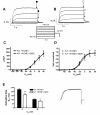Mutations in the potassium channel subunit KCNE1 are associated with early-onset familial atrial fibrillation
- PMID: 22471742
- PMCID: PMC3359244
- DOI: 10.1186/1471-2350-13-24
Mutations in the potassium channel subunit KCNE1 are associated with early-onset familial atrial fibrillation
Abstract
Background: Atrial fibrillation (AF) is the most common arrhythmia. The potassium current IKs is essential for cardiac repolarization. Gain-of-function mutations in KV7.1, the pore-forming α-subunit of the IKs channel, have been associated with AF. We hypothesized that early-onset lone AF is associated with mutations in the IKs channel regulatory subunit KCNE1.
Methods: In 209 unrelated early-onset lone AF patients (< 40 years) the entire coding sequence of KCNE1 was bidirectionally sequenced. We analyzed the identified KCNE1 mutants electrophysiologically in heterologous expression systems.
Results: Two non-synonymous mutations G25V and G60D were found in KCNE1 that were not present in the control group (n = 432 alleles) and that have not previously been reported in any publicly available databases or in the exom variant server holding exom data from more than 10.000 alleles. Proband 1 (female, age 45, G25V) had onset of paroxysmal AF at the age of 39 years. Proband 2 (G60D) was diagnosed with lone AF at the age of 33 years. The patient has inherited the mutation from his mother, who also has AF. Both probands had no mutations in genes previously associated with AF. In heterologous expression systems, both mutants showed significant gain-of-function for IKs both with respect to steady-state current levels, kinetic parameters, and heart rate-dependent modulation.
Conclusions: Mutations in KV7.1 leading to gain-of-function of IKs current have previously been described in lone AF, yet this is the first time a mutation in the beta-subunit KCNE1 is associated with the disease. This finding further supports the hypothesis that increased potassium current enhances AF susceptibility.
Figures






Similar articles
-
IKs Gain- and Loss-of-Function in Early-Onset Lone Atrial Fibrillation.J Cardiovasc Electrophysiol. 2015 Jul;26(7):715-23. doi: 10.1111/jce.12666. Epub 2015 May 4. J Cardiovasc Electrophysiol. 2015. PMID: 25786344
-
Gain-of-function mutations in potassium channel subunit KCNE2 associated with early-onset lone atrial fibrillation.Biomark Med. 2014;8(4):557-70. doi: 10.2217/bmm.13.137. Biomark Med. 2014. PMID: 24796621
-
A novel KCND3 gain-of-function mutation associated with early-onset of persistent lone atrial fibrillation.Cardiovasc Res. 2013 Jun 1;98(3):488-95. doi: 10.1093/cvr/cvt028. Epub 2013 Feb 11. Cardiovasc Res. 2013. PMID: 23400760
-
Gating and Regulation of KCNQ1 and KCNQ1 + KCNE1 Channel Complexes.Front Physiol. 2020 Jun 4;11:504. doi: 10.3389/fphys.2020.00504. eCollection 2020. Front Physiol. 2020. PMID: 32581825 Free PMC article. Review.
-
Recent molecular insights from mutated IKS channels in cardiac arrhythmia.Curr Opin Pharmacol. 2014 Apr;15:74-82. doi: 10.1016/j.coph.2013.12.004. Epub 2013 Dec 30. Curr Opin Pharmacol. 2014. PMID: 24721657 Review.
Cited by
-
Atrial fibrillation: the role of common and rare genetic variants.Eur J Hum Genet. 2014 Mar;22(3):297-306. doi: 10.1038/ejhg.2013.139. Epub 2013 Jul 10. Eur J Hum Genet. 2014. PMID: 23838598 Free PMC article. Review.
-
A KCNQ1 mutation causes a high penetrance for familial atrial fibrillation.J Cardiovasc Electrophysiol. 2013 May;24(5):562-9. doi: 10.1111/jce.12068. Epub 2013 Jan 25. J Cardiovasc Electrophysiol. 2013. PMID: 23350853 Free PMC article.
-
Association of KCNE1 genetic polymorphisms with atrial fibrillation in a Chinese Han population.Genet Test Mol Biomarkers. 2012 Nov;16(11):1343-6. doi: 10.1089/gtmb.2012.0149. Epub 2012 Sep 28. Genet Test Mol Biomarkers. 2012. PMID: 23020083 Free PMC article.
-
Arrhythmogenic Effects of Genetic Mutations Affecting Potassium Channels in Human Atrial Fibrillation: A Simulation Study.Front Physiol. 2021 May 31;12:681943. doi: 10.3389/fphys.2021.681943. eCollection 2021. Front Physiol. 2021. PMID: 34135774 Free PMC article.
-
Atrial fibrillation.Nat Rev Dis Primers. 2022 Apr 7;8(1):21. doi: 10.1038/s41572-022-00347-9. Nat Rev Dis Primers. 2022. PMID: 35393446 Review.
References
-
- Benjamin EJ, Wolf PA, D'Agostino RB. et al.Impact of atrial fibrillation on the risk of death: the Framingham heart study. Circulation. 1998;98(10):946–952. - PubMed
-
- Fuster V, Rydén LE, Cannom DS. et al.ACC/AHA/ESC 2006 guidelines for the management of patients with atrial fibrillation-excutive summary. Rev Port Cardiol. 2007;26(4):383–446. - PubMed
-
- Go AS, Hylek EM, Phillips KA. et al.Prevalence of diagnosed atrial fibrillation in adults: national implications for rhythm management and stroke prevention: the anticoagulation and risk factors in atrial fibrillation (ATRIA) study. JAMA. 2001;285(18):2370–2375. doi: 10.1001/jama.285.18.2370. - DOI - PubMed
-
- Psaty BM, Manolio TA, Kuller LH. et al.Incidence of and risk factors for atrial fibrillation in older adults. Circulation. 1997;96(7):2455–2461. - PubMed
Publication types
MeSH terms
Substances
LinkOut - more resources
Full Text Sources
Medical

